Original Article
Year: 2020 |Volume: 1 | Issue: 1 |Pages: 14-19
Drug efficacy of Khadiradi kashaya on Purishaj krimi.
About Author
Correspondence Address:
Dr S. K. Danga MD(Kayachikitsa ),MPH,PGDMLS,PDCR,MEFI,MCRI. Nagpur, Maharashtra Email: sunder147@gmail.com
Date of Acceptance: 2020-03-27
Date of Publication:2020-05-19
Article-ID:IJIM_3_05_20 http://ijim.co.in
Source of Support: nil
Conflict of Interest: nil
How To Cite This Article: Danga S.K. Petkar Shubhangi. Drug efficacy of Khadiradi kashaya on Purishaj krimi. Int. J Ind. Med. 2020;1(1):14-19.
Abstract
Background: In Ayurveda, various types, diagnosis & management of Krimiroga described in details in all Samhitas. There are two types of Krimi existing in human body– Sahaj & Vaikarik Krimi. Among them, Vaikarik Krimi is causative factor for disease in human being. Purishaja Krumi means "krumi born in the stools, which desire to migrate in the body from one organ or system to another, that which has the capacity to penetrate from one tissue to another and which gets nourishment from mansa." Aims & Objective: To study the efficacy of Khadiradi Kashaya – oral drug in Purishaj krimi (worm infestation). Material & Methods: Diagnosed total 30 patients of Purishaj Krumi were recruited in this clinical study from OPD Department of Kayachikitsa, Govt. Ayurveda Hospital, Nagpur. Khadiradi kashay (medicated Decoction) was prepared and given to the patients in the dose of 40 ml twice for seven days. Results and Discussion: Khadiradi kashaya could be a alternate choice Antihelminthic drugs in the management of Purishaj krimi; it has potential to cure the disease and also found relief in symptoms like vidbheda, shool, agnisada and Jwar of Purishaj krimi significantly. There was no any side effect of this drug observed during trial. Conclusion: Khadiradi Kashaya used in this study proves very good utility in the management of Purishaj krimi.
Keywords: Keywords: Purishaj krimi, Kushtha, Pandu, Grahani, Karshyata
Introduction
Intestinal worm infestation is one of the major concerns in childhood health problems in developing countries. In Ayurveda, various types, diagnosis & management of Krimiroga described in details in all Samhitas. By etymology, Krumi may be defined as the one which causes sufferings. [1] In Vedas also references have been cited regarding Krimi. In human body there are two types of Krimi – Sahaj & Vaikarik Krimi. Among them Vaikarik Krimi are harmful to human being. It is thought to considered that Krumi is one of the causes for Kushtha, Pandu, Grahani, Karshyata. Children are more sufferer comparison to adult. [2] Since worms are normally found in all human beings, mostly they are asymptomatic, symptoms observed with a few worms living inside the intestines. As per Indian study, Overall prevalence of intestinal worm infection was found to be 49.38%. Ascaris was the most common parasite (46.88%), followed by Taenia (2.1%) and Hymenolepis nana (0.21%). Cure rate was found to be 66% for Ascaris and 100% in other cases.[3]
In Krimi Samanya Chikitsa, Acharya Charaka has narrated the basic principle in the treatment of Krimi in the Vyadhita rupiya adhyaya of Vimana Sthana. [4] Consecutive adoption of the three methods of treatment has been stated which are-Apakarshana, Prakruti Vighata and Nidana Parivarjana. [5] Acharyas Charaka, [6] Sushruta[7], Vagbhata[8] and other Acharyas have given a systematic description of Krimi rogas including their classification, causative factors, signs and symptoms and treatment.
Krimi Lakshana (Symptomatology):
In clinical signs and symptoms of Abhyantara Krimi, Acharya Susruta and Madavakara have mentioned – Ajeerna (indigestion) and Angnimandhya (loss of digestive power)Jwara (fever), Vivarnata (discolouration), Shoola (pain), Hridroga (diseases of the heart), Bhrama, Bhaktadwesha (disinterest towards food) (giddiness), Atisara (diarrhoea), Sadana (tiredness), Chardi (vomitting) and Swasa (breathlessness). [9]
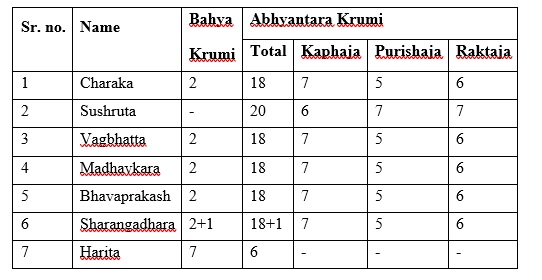
Table. 1 Types of Krumi:
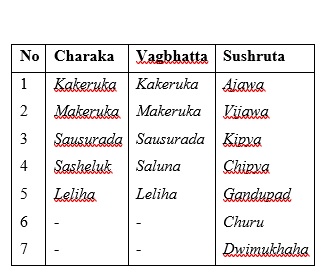
Table No. 2 Types of Purishaj Krumi according to Bruhattrai samhita:
Objectives-
1. To study the efficacy of Khadiradi Kashaya – oral drug in Purishaj krimi (worm infestation). 2. To study Purishaj krimi& its co-relation with worm infestation through Ayurvedic & modern texts.
Material & Methods:
Diagnosed total 30 patients of Purishaj Krumi were recruited in this clinical study from OPD Department of Kayachikitsa, Govt. Ayurveda Hospital, Nagpur. Patients were selected as per selection criteria from OPD & IPD of the Kayachikitsa department of the hospital. Khadiradi Kashaya (Khadir, Kutaj, Nimba, Triphala, Trikatu) fresh 40 ml and Gomutra of healthy cow was given as an anupan prescribed by Yog-Ratnakar for the duration of 7 days. In case of unavailability of fresh Gomutra, Gomutra-Arka was used. Criteria for Diagnosis:- Diagnosis was mainly depending upon clinical features described in the texts of Ayurveda and at same time sign & symptoms mentioned in the modern aspects would be taken into consideration. After reviewing the literature, it was decided that any case that showed two or more purvrupa - praseka, rhullas, agnimandya and vidbhed - and one or more of the six rupa - agnimandya, shul, praseka, vidbhed, gudakandu and foul-smelling stools - were considered as positive for clinical diagnosis for Purishaja Krumi Vyadhi. Microscopic Stool examination were considered for confirmation of diagnosis.
Observations and Results:
In this study 30 patients of Purishaj krimi were studied. All collected data (Before Treatment & After Treatment) regarding patients has been analyzed statistically. Dominant Guna in Diet- Out of 30 Patients of Purishaj krimi 20(66.67%) patients were taking diet which was dominant in Guru Guna while 19(63.3)% patients were taking diet dominant in Snigdha Guna and 09(30) % Patients were Dominant in Sheet Guna. Out of 30 Patients of Purishaj krimi 25(83.3%) patients were taking diet which was dominant in Madhur Rasa while 21(70)% patients were taking diet dominant in Amla Rasa and 46.67%, 13.33 %, 26.67%, and 10% in Lavan, Katu,Tikta, Kashyay Rasa respectively . Percentage of Relief in Symptoms Score:- : In the present study of 30 patients of Purishaj Krimi in Trial Group, Percentage of relief was 95.65 % in Vidbheda, 86.21% in Udarshool, 75.68 %in Vishtambha, 90% in Gudkandu, 80% in Parushata, 78.05 in Panduta, 71.43 in Romharsha,76.92 in Agnisada, 85.71, 100, 80, 33.33, 91.67, 96.15 in Karshyata, Jwar, Vivarnata, Hridroga, Bhrama and Bhaktadwesha respectively.
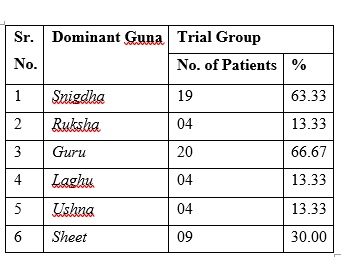
Table 3. Distribution of 30 Patients of Purishaj Krimi, Taking Dominant Guna in Diet
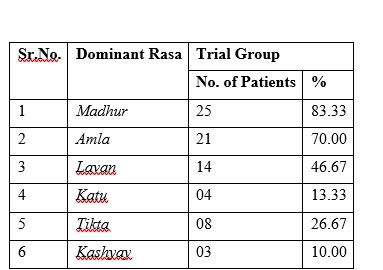
Table 4. Distribution of Patients of Purishaj Krimi,Dominant Rasa in the Diet:-
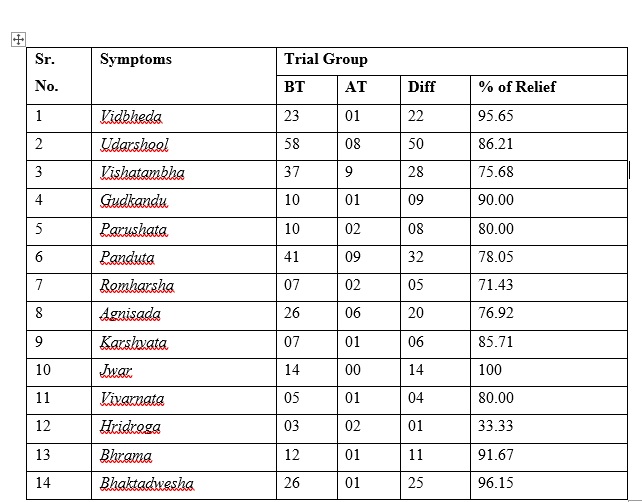
Table 5. Percentage of Relief in Each Symptom of 30 patients of Purishaj Krimi
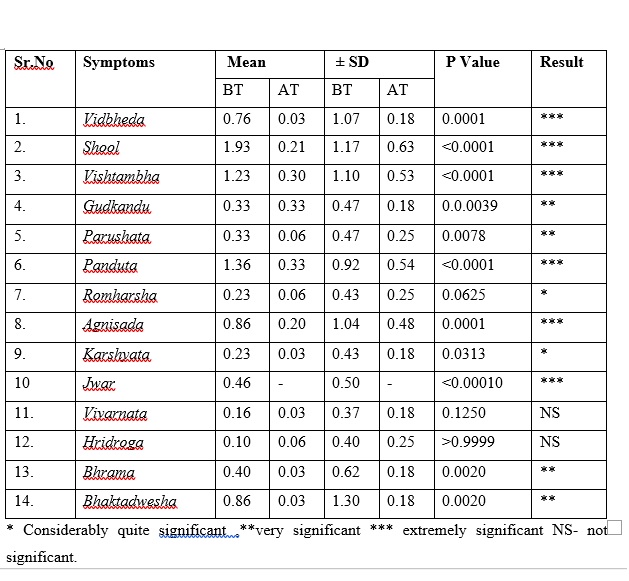
Table 6. Wicoxon Signed Rank Test on Symptom score of Purishaj Krimi.
Discussion
If there is additional and excess kled, and ama in the human body which results in agnimandya and simultaneously probability of production and development of Purishaja Krumi is increased because kled and ama itself acts as the basis for Krumi Utpatti. Masha, Gud, Pishtmma, Til, Sngidha and sheet ahar, Lavana rasatmak ahar, Anoop mansa, Madhura rasatmak ahar, Kusumbha sneh, Viruddha ahar, Avyayam, Paryushit ahar, Divaswap and Asatmya ahar are considered the main causative factors for purishaj krumi. Eating outside food like fast food, bakery product, eating vada pav, samosa, pav bhaji, eating non veg foods, the properties of these food items are ushna, tikshna, vidahi, and guru (heavy for digestion). [10] Madhura ras is heavy for digestion because it is having pruthvi and jala mahabhuta pradhan.
This leads to aggravation of Kapha, which causes agnimandya. These give rise to kshudhamandya, thus aggravating amotpatti and ultimately resulting in excess kled utpatti which results into krumi in the stomach and intestine. Khadiradi Kashaya having has properties like krimighna, kandughna, drug like Nishottar has laxative property while triphla & trikatu has deepan as well as pachan property. Gomutra has lekhan and sara property. Overall this formula was dominantly having katu ,tikta and kashaya rasatmak guna and having tikshna guna along with ushna virya which results in destruction of samprati of Purishaj krimi.[11]
Conclusion
Helminthiasis is one of the most common paediatric problem faced world-wide es-pecially in tropical and sub-tropical geographical area. Khadiradi Kashaya drug is useful and observed very effective in reducing signs and symptoms of Purishaj krimi.
References
value="
- Vaidya YT, editor. Charaka Samhita by Agnivesha, Sutra Sthana; Arthedashamaha-muliyam Adhyayam: Chapter 30/28. Varanasi: Chaukhambha Prakashan, Reprint 2009; p.189
- Mishra D.N., Kaumaravrittya, Chawkhamba Sanskrit Pratishthan, Delhi, 2012
- Kumar H, Jain K, Jain R. A study of prevalence of intestinal worm infestation and efficacy of anthelminthic drugs. medical journal armed forces india. 2014 Apr 1;70(2):144-8.
- Vaidya YT, editor. Charaka Samhita by Agnivesha, Vimana Sthana; Vyadhitarupiyam Adhyayam: Chapter 7, Verse 10. Varanasi: Chaukhambha Prakashan, Reprint 2009; p.257.
- Vaidya YT, editor. Charaka Samhita by Agnivesha, Vimana Sthana; Vyadhitarupiyam Adhyayam: Chapter 7, Verse 28. Varanasi: Chaukhambha Prakashan, Reprint 2009; p.261.
- Vaidya YT, editor. Charaka Samhita by Agnivesha, Sutra Sthana; Aushtaudariyam Adhyayam: Chapter 19, Verse 4. Varanasi: Chaukhambha Prakashan, Reprint 2009; p.111.
- Vaidya YT, editor. Sushruta Samhita of Sushruta; Uttara Tantram; Krimiroga-pratishedham Adhyayam: Chapter 54, Verse 7. Varanasi: Chaukhambha Surbharati Prakashan, Reprint 2003; p.773.
- Sharma Shivprasad (edi), Astangasamgraha of Vriddha Vagbhata with Shashilekha Sanskritt commentary by Indu, 3rd ed. Nidana Sthana; Kriminidanam Adhyayam: Chapter 14, Verse 59. Varanasi: Chowkhamba Sanskrit series office; 2012. p.413
- Vaidya YT, editor. Charaka Samhita by Agnivesha, Vimana Sthana; Vyadhitarupiyam Adhyayam: Chapter 7, Verse 13. Varanasi: Chaukhambha Prakashan, Reprint 2009; p.258.
- Babu Amal P. A Review on the Management of Pureeshaja Krimi (Ascaris Lumbricoides), IAMJ: 3( 4) 2015,p.1093-98
- Danga SK & et al. Clinical Study of Khadiradi kashaya in Purishaj krimi With special reference to Worm Infestation. International Journal of Ayurvedic Medicine, 2014, 5(4), 315-320
"

